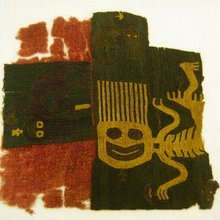Textile Fragment with Skeletal Figure
Brooklyn Museum
33.570a-b
Two fragments from a Paracas mantle woven in red and brown with skeletal human figures holding fans or tumi knives. Larger fragment with face is "a"; smaller fragment with full figure is "b".
-
Label
The backward-bent pose of this skeletal figure with long, streaming hair and a fan or knife in its hand is associated with sacrificial victims and death. At the throat, a square-shaped wound suggests a decapitation. Alternatively, the figure has been interpreted as the seminal being of a mythic transformation sequence in which supernatural beings evolve into more complex, composite figures such as the Plant Beings seen nearby.<br /> <br /> <br /> La pose torcida hacia atrás de esta figura esquelética con largo pelo flotante y un abanico o cuchillo en su mano está asociada a las víctimas de sacrificio y a la muerte. En la garganta, una herida cuadrada sugiere decapitación. Alternativamente, esta figura ha sido interpretada como el ser seminal de una transformación secuencial en la que seres sobrenaturales se convierten en figuras compuestas más complejas, como los Seres Vegetales que se ven cerca.<br />
-
Credit Line
A. Augustus Healy Fund
- Type of Item textile fragment, figure
- Culture Paracas
- Material cotton, camelid fiber
- Creation Date between 101 BCE and 1
- Classification Textile

